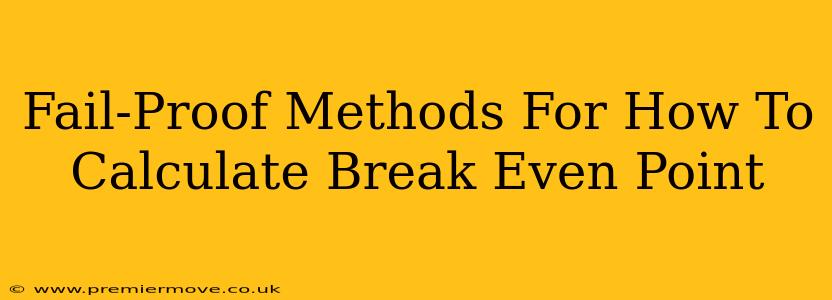Want to know the magic number where your business starts turning a profit? That's your break-even point. Understanding how to calculate it is crucial for any entrepreneur, small business owner, or even just someone planning a side hustle. It's not rocket science, but it is a powerful tool for financial planning and success. This guide provides fail-proof methods to calculate your break-even point, ensuring you're always one step ahead.
What is the Break-Even Point?
Simply put, your break-even point is the point at which your total revenue equals your total costs. This means you're neither making a profit nor losing money; you're breaking even. Knowing this point helps you:
- Set realistic pricing: Avoid pricing your products or services too low, leading to losses.
- Manage expenses: Identify areas where you can cut costs to reach profitability faster.
- Make informed decisions: Assess the viability of new products or expansion plans.
- Secure funding: Show investors the potential for profitability.
How to Calculate Your Break-Even Point: Two Key Methods
There are two primary methods for calculating your break-even point: one focused on units sold and another on sales revenue.
1. Break-Even Point in Units
This method tells you how many units you need to sell to cover all your costs. The formula is:
Break-Even Point (Units) = Fixed Costs / (Selling Price Per Unit - Variable Costs Per Unit)
Let's break down each component:
- Fixed Costs: These are costs that remain the same regardless of production volume (e.g., rent, salaries, insurance).
- Selling Price Per Unit: The price at which you sell each product or service.
- Variable Costs Per Unit: Costs that change directly with production volume (e.g., raw materials, direct labor).
Example:
Let's say you're selling handmade candles.
- Fixed Costs: $1,000 per month (rent, utilities)
- Selling Price Per Unit: $20 per candle
- Variable Costs Per Unit: $8 per candle (wax, wicks, fragrance)
Break-Even Point (Units) = $1000 / ($20 - $8) = 83.33 units
You need to sell approximately 84 candles to break even.
2. Break-Even Point in Sales Dollars
This method reveals the total revenue you need to generate to cover all your costs. The formula is:
Break-Even Point (Sales Dollars) = Fixed Costs / ((Sales Price Per Unit - Variable Costs Per Unit) / Sales Price Per Unit)
Using the same candle example:
Break-Even Point (Sales Dollars) = $1000 / (($20 - $8) / $20) = $1666.67
You need to generate approximately $1667 in sales revenue to break even.
Beyond the Basics: Factors to Consider
While these formulas are straightforward, remember that several factors can influence your break-even point:
- Seasonality: Demand for your product or service may fluctuate throughout the year.
- Competition: Aggressive pricing from competitors can impact your sales volume.
- Economic conditions: Recessions or economic downturns can affect consumer spending.
- Pricing strategies: Sales, discounts, and promotions can influence your break-even point.
Regularly Review and Adjust
Your break-even point isn't static. Regularly review your costs and sales figures to recalculate your break-even point and adjust your business strategy accordingly. This proactive approach will ensure you're always on the path to profitability. By mastering these methods, you’ll gain valuable insights into your business's financial health and make more informed decisions for sustainable growth.

